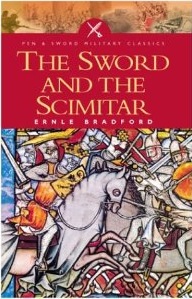
De Re Militari | Book Reviews
Ernle Bradford
The Sword and the Scimitar
Barnsley, UK: Pen & Sword, 2004. ISBN 9781844150410. £7.99. 192pp.
Pen & Sword’s Military Classics series reprints classic works in military history and Ernle Bradford’s The Sword and Scimitar (originally subtitled The Saga of the Crusades in 1974) fits nicely into this series. Indeed, it is a lively survey of the Crusades from their inception to the fall of Acre in 1291.
Although it is a reprint, Bradford’s work still has use due to its strong emphasis on the military history of the crusade, truly representative of the previous generations of Crusader historians. However, as it is indicative of that earlier generation, it is also very weak on the social history of the Crusades and this lapse truly shows the book’s age. In regards to the Children’s Crusade, Bradford depicts it as actual children (pueri) departing on the Crusade, rather than the poor. This is not a criticism of Bradford’s book, indeed Pen & Sword has not made any attempt to revise or update the work but rather simply republish key works. Nonetheless, this example, if nothing else, is the decisive evidence of why “classic” works are good to read, but one must keep up with the historiography.
Bradford also falls into outdated methodology and stereotypes—his work is replete with depictions of the great, manly, northern and western Europeans venturing to the East and imposing their will on it, only to see successive generations and indeed many newcomers becoming “soft” and over-indulgent after they are exposed to Oriental luxury. Apparently frequent bathing is a bad thing. This is one reason why he believes the Crusades failed—not just those who settled in Middle East, but all of the Crusades in general. He postulates that the egos of the nobility often became more concerned with shares of plunder, land, as well as well title. After all, they were all the most important person in their own provincial world, yet thrown together on a Crusade the nobility quickly learned that being a Count in one part of France was not the same as being a Count in another part of France. In many ways, while parts of his argument can be easily dismissed, Bradford’s idea does have a ring of accuracy. For evidence one may just witness “super-star” athletic teams today where star athletes are assembled in expectation of instant championship only to find out that there is no chemistry or team identity as each player focuses on his own statistics, salary, and needs in order to appear as the most important star on the team.
Yet why would one want to read an admittedly outdated work? To begin with, it is exceedingly well-written, although the lack of footnotes or other forms of citations can be a bit maddening. What Bradford does very well is found in his use of quotations from the primary sources that lend color and life to his narrative. Bradford, really in all of his works, had an excellent eye for selecting the appropriate passage to vividly bring an episode of history together. In addition, Bradford does an exceptional job of commenting rather objectively on the personalities of various participants. Upon reading this and then reflecting on a number of more recent narratives of the Crusades, this is truly a skill that is lacking among many current scholars. While objectivity is a priority, our understanding of historical figures as people (or at least the depiction) often appears to have taken a backseat thus rendering them as two-dimensional and rather forgettable. Bradford, however, is able to describe historical figures and bring them to life by essentially using the same facts but by being more judicious in his phrasing. Finally, one should comment on the idea of pilgrimage, which indeed, was a crucial part of the Crusader identity. From the perspective of an undergraduate student or general public, the first two chapters of Bradford’s The Sword and the Scimitar provides one of the better explanations of the idea of pilgrimage and its importance in the medieval world.
In conclusion, while the book does show its age it still is very useful in terms of military history. While readers of Smail or France’s studies of Crusading warfare will gain little new from it, Bradford does go into more detail on the style of warfare of each participant as well as some of the evolution. By placing it in the context of the general narrative and not just as a separate chapter, the reader receives the information in context of the flow of events. Thus it remains an adequate introduction, albeit it is recommended that one pairs it with a more survey with an updated historiography as much of our understanding of the Crusades has changed since 1974.
